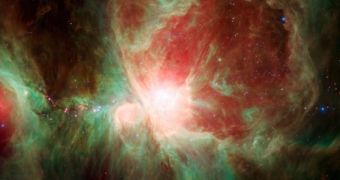Astronomers operating the NASA Spitzer Space Telescope used the spacecraft's enormous power to resolve light at infrared wavelengths to collect a new image of the Orion Nebula. This extremely well-known stellar nursery is located just 1,500 light-years away from Earth.
The false-color image above shows a portion of the nebula, with Spitzer's field of view covering around 40 light-years. Reddish hues in the photo code for protostars, which are very young stars that have not yet fully formed, and are still encased in their protective dust cocoons.
Experts say that the brightest portion of the stellar nursery remains the Trapezium Cluster, which also shines brightly at optical wavelengths. This cluster concentrates a very large population of extremely-young, extremely-bright blue stars. The ultraviolet radiations they release ionize the hydrogen gas throughout the nebula, making it shine brightly for this picture.
The Orion Nebula is located south of Orion's Belt in the night sky, and is one of the brightest such structures discovered to date. It can be seen with the naked eye from Earth, and resolves beautiful when using telescopes or binoculars. Its other names are MGC 1976 and Messier 42.

 14 DAY TRIAL //
14 DAY TRIAL //